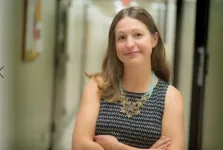At underwater site, research team finds 9,000-year-old stone artifacts
Underwater archaeology team finds ancient obsidian flakes 2,000 miles from quarry
2021-06-15
(Press-News.org) An underwater archaeologist from The University of Texas at Arlington is part of a research team studying 9,000-year-old stone tool artifacts discovered in Lake Huron that originated from an obsidian quarry more than 2,000 miles away in central Oregon.
The obsidian flakes from the underwater archaeological site represent the oldest and farthest east confirmed specimens of western obsidian ever found in the continental United States.
"In this case, these tiny obsidian artifacts reveal social connections across North America 9,000 years ago," said Ashley Lemke, assistant professor of sociology and anthropology at UT Arlington. "The artifacts found below the Great Lakes come from a geological source in Oregon, 4,000 kilometers away---making it one of the longest distances recorded for obsidian artifacts anywhere in the world."
The unique study was a multi-faceted pursuit with divers in the water and researchers in the laboratory from UTA, the University of Michigan, Lake Superior National Marine Conservation Area, the University of Missouri Research Reactor Center, the Northwest Research Obsidian Studies Laboratory and the University of Georgia. Their combined work, "Central Oregon obsidian from a submerged early Holocene archaeological site beneath Lake Huron," was published last month in the journal PLOS One.
Because the site was underwater and undisturbed, researchers systematically and scientifically recovered the obsidian, a form of volcanic glass that was used and traded widely throughout much of human history as a prized material for making sharp tools.
"These are very small pieces that have very large stories to tell," Lemke said. "Obsidian from the far western United States is rarely found in the east."
Lemke is a leader and innovator in the field, serving as the chair of the Advisory Council on Underwater Archaeology, an international group dedicated to underwater archaeology and the preservation of underwater cultural resources. She is an expert on submerged ancient sites in the Americas and has researched other areas such as the Gulf of Mexico and Atlantic Ocean.
The find in Lake Huron is part of a broader study to understand the social and economic organization of caribou hunters at the end of the last ice age. Water levels were much lower then; scientists have found, for example, ancient sites like stone walls and hunting blinds that are now 100 feet underwater.
"This particular find is really exciting because it shows how important underwater archaeology is," Lemke said. "The preservation of ancient underwater sites is unparalleled on land, and these places have given us a great opportunity to learn more about past peoples."
INFORMATION:
[Attachments] See images for this press release:

ELSE PRESS RELEASES FROM THIS DATE:
2021-06-15
"So, no one told you life was going to be this way.
Your job's a joke, you're broke, you're love life's DOA.
It's like you're always stuck in second gear,
When it hasn't been your day, your week, your month, or even your year..."
If you have watched TV since the 1990s, the sitcom theme song, "I'll Be There for You," has likely been stuck in your head at one point or another. New research from UC Davis suggests these experiences are more than a passing nuisance -- they play an important role in helping memories form, not only for the song, but also related life events like hanging out with friends ...
2021-06-15
When a fictional female journalist appears on screen, chances are she's about to sleep with one of her sources. It's a trope that infuriates actual women in news media -- and it can have real-life consequences, says University of Florida researcher Frank Waddell, Ph.D.
In shows like "House of Cards" and movies like "Thank You for Smoking," female reporters are quick to trade sex for information. Even when sex with sources has nothing to do with ambition -- such as the hookups in "Sharp Objects," "Top Five," "Trainwreck," and the "Gilmore Girls" reboot, to name a few -- it still portrays unethical behavior.
"In the past 20 to 30 years, Hollywood has really latched on to this. ...
2021-06-15
A study of media coverage of 623 scientific papers on Alzheimer disease research conducted in mice reveals that the news media are more likely to write a story about alleged breakthroughs or medical research findings if research authors omit mice from their studies' titles. On the other hand, papers that acknowledge mice in their titles result in limited media coverage.
In addition, the study titled "What's not in the news headlines or titles of Alzheimer disease articles? #In mice" conducted by Dr Marcia Triunfol of Humane Society International and Dr Fabio Gouveia of the Oswaldo Cruz Foundation in Brazil, and published in PLoS ...
2021-06-15
Discussions of a broken value system are ubiquitous in science, especially after the COVID-19 pandemic served to expose inequality globally. However, according to the authors of an article publishing 15th June 2021 in the open access journal PLOS Biology, science itself is not "broken," but it was built on deeply-entrenched, systemic sexist and racist values, which perpetuate biases through the continued focus on citation rates and impact factors.
The author maintain that while equity within science has advanced thanks to the tireless efforts of generations of systemically marginalized groups, the system remains outdated, colonialist, and patriarchal. ...
2021-06-15
Financial toxicity, the financial strain experienced by patients accessing health care, impacts a large population of cancer patients according to prior research. A new study, published in JACC: CardioOncology, finds financial toxicity is often greater among heart disease patients compared to cancer patients, and those with both conditions suffer the highest burden.
"Heart disease and cancer are the leading causes of death in the United States, yet most research on financial toxicity has focused on cancer patients. It is important to consider that cancer patients may have short bursts of high expenditures for treatments, while heart disease patients are often incurring ...
2021-06-15
The number of people dying from cardiovascular disease (CVD) in Asia is increasing rapidly, with over half of all CVD deaths globally in 2019 occurring in Asian countries, according to a state-of-the-art review paper published in the inaugural issue of JACC: Asia. The data demonstrates an urgent need to understand the burdens and epidemiological features of CVD in Asian countries to develop localized CVD prevention strategies to combat the epidemic.
From 1990 to 2019, the number of CVD deaths in Asia rose from 5.6 million to 10.8 million. Nearly 39% of these CVD deaths were premature, meaning they occurred in a person less than 70 years old, which was significantly higher than premature CVD deaths in the U.S. (23%). Most ...
2021-06-15
There is increasing scrutiny around how science is communicated to the public, but what is the relationship between how scientists report their findings and how media reports it to the public? A study published in PLOS Biology by Marcia Triunfol at Humane Society International, in Washington, DC and Fabio Gouveia at Oswaldo Cruz Foundation in Rio de Janeiro, Brazil suggests that when authors of scientific papers omit the basic fact that a study was conducted in mice (and not in humans) from the article title, journalists reporting on the paper tend to do the same.
Alzheimer's Disease is an exclusively ...
2021-06-15
What will the Earth be like for our children and grandchildren, as temperatures continue to rise? We can be fairly certain of some things: Some regions will become inhospitable, as heat drives their inhabitants away or causes massive declines and changes in their ecosystems. Many other physical, chemical and biological processes will also be affected by rising temperatures that threaten critical ecosystem services such as food production, biodiversity and energy security.
But what these changes will be and exactly how they impact the Earth -- and ultimately us humans -- are still difficult to predict. Many of them are so gradual and happen over such a long timescale that they wouldn't be noticeable ...
2021-06-15
Federal agencies that regulate drug pricing and healthcare insurance are concerned that an industry practice of using rebates to lower drug costs for insurers has led to increases in list prices and out-of-pockets costs for patients.
To investigate whether patients with or without insurance were paying more because of rebates to insurers, researchers led by the University of Washington examined cost and price data on more than 400 branded drugs. The study found that rebates were associated with increases in out-of-pocket costs for patients by an average of $6 for those with commercial insurance, $13 for Medicare ...
2021-06-15
In 1943, two scientists named Max Delbrück and Salvador Luria conducted an experiment to show that bacteria can mutate randomly, independent of external stimulus, such as an antibiotic that threatens a bacterial cells' survival. Today the Luria-Delbrück experiment is widely used in laboratories for a different purpose--scientists use this classic experiment to determine microbial mutation rates. When performing the Luria-Delbrück experiment, scientists need efficient computer algorithms to extract reliable estimates of mutation rates from data, and they also need well-designed software tools to access these sophisticated algorithms.
Through the years, several web tools that allow researchers to more easily input and analyze data on a computer were developed to increase ...
LAST 30 PRESS RELEASES:
[Press-News.org] At underwater site, research team finds 9,000-year-old stone artifacts
Underwater archaeology team finds ancient obsidian flakes 2,000 miles from quarry

